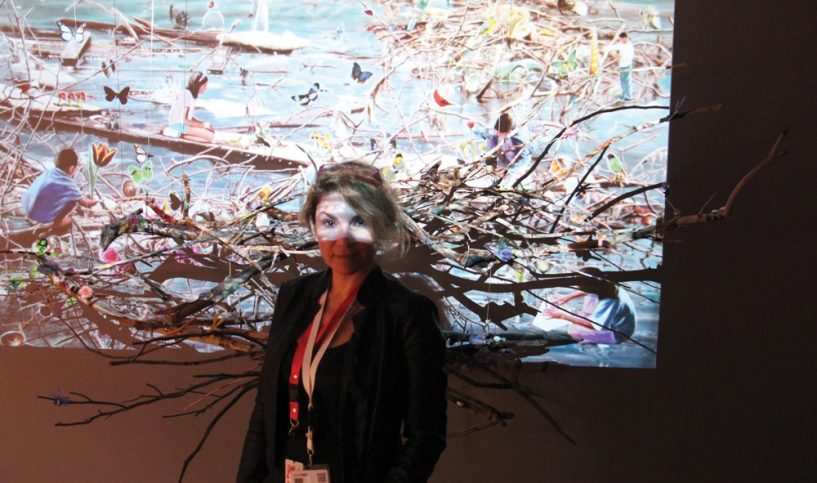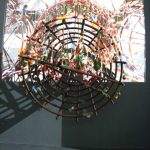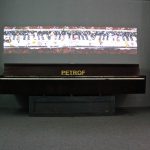Our last interview with Shurooq Amin (March 2012) left both this bazaar writer and the artist with much pride, and trepidation. I distinctly remember Shurooq voicing her concerns about the show, “I’ve never cared for peoples’ reactions, critics’ reviews or sales. I worry that the owner gets in trouble, or that the gallery could decide not to show one or two pieces from my series.” Nonetheless, the AL M. Gallery showed the artist unbounded support, and all of Shurooq’s pieces went on display. To everyone’s shock and dismay, however, It’s A Man’s World’s opening night was shortly lived, and the show was quickly shut down.
While this shutdown surprised us all, Shurooq Amin did not shrink away from the controversy, she did not back down. The artist persevered and has most certainly moved on.
Today, we celebrate many milestones for Shurooq Amin since her move to partner with the Dubai-based Ayyam Gallery. She is the first female Kuwaiti artist to exhibit at the Venice Biennale amongst a roster of accomplished Middle Eastern artists. The first female Kuwaiti to be interviewed on BBC’s HARD TALK by Stephen Sackur, the first Kuwaiti artist whose work was sold at the prestigious Christie’s auction house, and the first Kuwaiti to be nominated for the Pushcart Prize in Poetry in the USA. Join us for this heartfelt sit-down with the artist as she discusses a journey that aptly bears resemblance to her latest body of work, We’ll Build This City on Art and Love.
Hi Shurooq! We last conversed right before the unveiling, and then-imminent shutdown, of your solo show, It’s a Man’s World. Would you say that your next series, Popcornography, arrived as a response to the shutdown of your show?
Of course, albeit unintentionally. What happened was I printed some of the hundreds of emails of support that I received from the international community and started pasting them onto a block of wood, which inadvertently became the first painting of Popcornographic, and was entitled To Kill a Mocking Girl. All the titles from Popcornographic were a twist on a banned movie or book from the past, to indicate that history repeats itself, but always shows us the end result anyway (everything unjustly banned becomes accepted one day). Popcornographic itself, as a title for my show after the shut down and censorship of It’s a Man’s World, was a word my little girl used at the time. She asked me why she was hearing people call my show “popcornographic” (she didn’t know the connotation of the word, nor could she pronounce it). Et voilà! A title was born.
What happened next? How did this affect you mentally and artistically?
I was devastated. The effects on me were far more than anyone ever imagined. I went into a depression for a few weeks. My children suffered at school both in performance and due to severe bullying. My family – mother especially – suffered as well. The media couldn’t get enough for weeks and weeks; painting me into something I’m not, publishing unauthorized images of my paintings and then blackening them out with marker as if they were obscene, etc. Local artists and art patrons were divided. Some supported me and I will never forget those people. And those who unjustly attacked me, may God forgive them. They were, and still are, I suppose, afraid. Artistically, though, it was a godsend for me. One day, I just dragged myself out of bed, and found the strength to read through my hundreds of emails (I was terrified to read them, because there was a lot of hate mail and death threats), and I was surprised to find so much love from the international community, from fans in towns I’ve never even heard of, to well known art collectors, curators, institutions and museums, all sending me emails of love and support. That’s what gave me the strength and power to keep going harder than ever, more determined then ever, to spread the truth. The truth shall set you free. I believe that. I believe that only by confronting our problems, limitations and faults, can we discuss, solve and fix, to become a better society. If you don’t look in the mirror and see yourself for what you truly are, you can never become a better version of yourself. And it’s the same with our society; we can never progress if we don’t address serious issues that need solutions.
Can you tell us more about your journey with “We’ll Build This City on Art and Love”?
After Popcornographic, I started working on my 2014/2015 series We’ll Build This City on Art and Love. The title is from an eighties song, and the twist for me comes in the response to the Syrian war. My mother is Syrian, and like all Syrians, our family there suffered; she went through her own version of devastation and uprooting. Sadly, one of my uncles and his wife are still staying in Damascus and refuse to leave, despite my mother’s imploring them to come stay with us in Kuwait. The theme is about rebuilding and reconstructing, after all that destruction and hate.
I focused on different ideas this time, unlike Society Girls and It’s a Man’s World, which explored regional social issues and taboos; and unlike Popcornographic, which explored censorship and was a direct response to the shut down of my show; the new series took on both serious and sarcastic implications, with the simple straightforward meaning of re-building cities, minds, and beliefs that have been destroyed / deconstructed due to corruption and dogmatic, hypocritical ideologies.
Most titles of paintings were a twist on chapters from Lewis Carrol’s books Alice in Wonderland, The Hunting of the Snark, etc. Each title gave humor to an otherwise grave issue. For example: Painting the Roses Red: This Way Up, Fashionista: The Mad Hattress, Through the Looking Glass: Child Bride, The King of Hearts, Piece of the Pie: Who Stole the Tarts? All of these explore global issues, but then I explored very local issues that represented and symbolized bigger worldwide problems, like questions raised with regards to the delayed governmental projects, as in Silk City: Pipe Dreams, Waiting for Dodo, and Education and Beyond. The painting We Are The Future: Picking Up the Pieces explores the lack of care for mental health patients in the region, and how we pay no attention to the health of our brain, focusing mainly on the external aesthetics of perfect noses and steroid-induced biceps. The largest painting MARA7=7ARAM explores the issues of social taboos, and questions the validity of morality in our society; what is really wrong and right? The two family portraits portray unorthodox yet perfectly normal families that exist all around us and ask the viewer to change their preconceived notions of what a family really is.
I also went to Taima and discovered how the Bidoon in our society really live, and it infuriated me, so I created a book installation called: The Story of the Bidoon. I did the title in English, Arabic and Braille, to symbolize how blind we are to the plight of the stateless. I originally wanted to take photos of the actual people, but when I got there, I was overwhelmed with the graffiti that was on every surface, so I took photos of that instead. My book tells the story of the emotional and mental state of the Bidoon through their graffiti, and of course, it inadvertently tells their physical story because of the pitiful state of their homes. That show exhibited in Dubai then in London, both times with Ayyam Gallery.
How did you come to be a part of a group exhibition at the 56th Venice Biennale?
I got a call back in October 2014 from the founder of Contemporary Practices, inviting me to be a part of their pavilion at Venice Biennale. It was random and unexpected, and I was in tears of joy at this great opportunity. It all depended on if my gallery would accept, and thank goodness, when Contemporary Practices contacted Khaled Samawi, owner of Ayyam, he said yes straight away. After a couple of weeks, I was connected to the wonderful curator Martina Corgnati, and I shared with her my concept for the biennale.
Can you tell us more about your installation? What did this opportunity mean to you?
Well I knew that I wanted to do something out of my box, something that I had never tried before. I’d always been a painter, so obviously I wanted to move away from 2D and into installation. But I still wanted to remain true to my vision and my story, so I took 3 paintings from my previous show, We’ll Build This City on Art and Love, and worked to bring them to life. I created an entire room with three sculptures and three projections. The viewer walks into a 5-meter x 5-meter room. There are 3 projectors hanging from the ceiling, attached to media players that are running a separate USB for each projector. The projection facing the viewer is that of a painting called MARA7=7ARAM (Fun = Forbidden), which is 3 meters wide. Hovering in front of the projection, on a camouflaged wooden crate, is a piano installation (reflecting the piano in the projected painting; therefore, also 3 meters long), so that the overall image is a 3D effect. By playing with the image, utilizing it as a mirror image of one word for another, whereby the text “mara7” is actually “7aram” spelled backwards, the powerful sardonicism of the concept is emphasized. The image and the title are inseparable: one playing off the other in a ping-pong atmosphere of incongruity. The artwork deals with the concept of taboo in Islamic Arabian Gulf society. The keyboard of the giant piano sculpture is distorted, representing the distorted morality of people in the region of what is right and wrong. And the two lizards climbing the piano symbolize the overcoming of fear (due to a personal incident that happened to me in my childhood).
On the right hand wall is a projection of a painting called A Tangled Tale (2 meters wide), and in front of that, also, hanging from the ceiling with invisible string, is an installation sculpture of giant swirling metal piping, mimicking the piping in the projected painting, thus inducing the same 3D effect for the viewer (also 2 meters wide). A Tangled Tale addresses the questions raised due to delayed projects, and hence, a stagnant society, arrested development and regression as opposed to progression over time. A motif of whimsy, humor, children and fairies dilutes the grim potentially perilous subject. The flowers, however, are wilted, and the new generation is confronted with ample building, reconstructing, considerable threading and sewing and stitching, before future generations can reap positive benefits after this generation’s destruction.
On the left hand wall is a projection of a painting called Pollutoland (2 meters wide), in front of which also hangs a 2-meter wide installation sculpture of twigs and branches of dead trees (from translucent strings attached to the ceiling), reflecting the pollution-image in the projected painting. I actually pulled the dead trees and garbage out the sea in Kuwait and epoxied them into a beautiful sculpture for Pollutoland, which deals with the concept of environmental awareness in the Middle East (or lack thereof!). There is beauty even behind the ugliness, and a stereotypically repulsive image, unwanted and neglected, can actuate hope in the viewer, thus instigating proactivity. Pollutoland transforms the disheartening mantle of sea debris into a whimsical scene with fairies and children cleaning up and purifying the flotsam and jetsam left behind by both the insouciant negligence of people (as in the detritus of plastic bottles, nylon bags, soda drinks, etc) and institutions (as in the oil spills and other chemical contamination).
The floor is covered with sand under each sculpture, reflecting the desert environment of the Arabian Gulf. The music playing for my installation is taken with permission from the wonderful composer Brian Crain, who allowed me to use 3 of his piano compositions for my Venice installation.
Did you enjoy the process, would you do it again?
The process was the hardest, most grueling, most emotional, most physically draining and mentally fatiguing process I’ve ever been through in my life. Everybody at the pavilion had a difficult day at some point or another, everyone was emotionally highly-strung. Everything is complicated in Venice, especially as it is not a practical city and to just buy a wire, you have to travel an hour to the nearest mall in another city, and everything is by water, etc., but we all helped each other. I was on a ladder painting my projector wires gray to match the walls and camouflage them the day before the opening night, and I was vacuuming and brushing the floor, and I was packing paperwork for the media package, etc. Not just me: everyone was helping in any way they could. I loved every minute of it and I would most certainly do it all over again, especially as now, I know so much about the biennale and the process and Venice itself.
While you are constantly trying, and rightfully succeeding, in representing Kuwait in the international arena, your work sometimes goes by unrecognized. Do you ever feel like giving up?
I was the only Kuwaiti in Venice this year, and I am actually the first Kuwaiti female artist to exhibit at the Venice Biennale. That is a huge honor appreciated by the biennale, by my commissioner, by my curator, and by my gallery, but not my country, sadly. But give up? Never! That’s like asking me to stop breathing on purpose; I couldn’t even if I wanted to. I’m here to stay, and I think I am proving that show-by-show. And for those who are still hung up on me being the censored artist, whose show was shut down, move on! I’ve come a long way since then, maybe they should, too.
Visit ShurooqAmin.com for more information, and you can follow the artist on Twitter and Instagram @ShurooqAmin.














